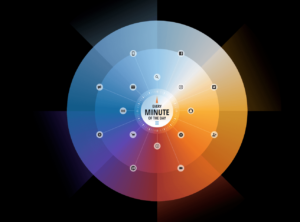 The latest “Data Never Sleeps” shows the breathtaking amount of data created every minute on the internet: (See the full infographic here.)
The latest “Data Never Sleeps” shows the breathtaking amount of data created every minute on the internet: (See the full infographic here.)
We’re asking Google questions (5.9 million every minute), uploading to YouTube (500 hours), sharing photos on Instagram (66,000). We’re tweeting (347,000), sharing content on Facebook (1.7 million) and sending email (231 million). Not to mention the rising star, TikTok!
No wonder your chances of being on the right channel at the right time to see a specific post are, well, zero. So here again are some of the helpful, interesting links I’ve shared that you might have missed, all to do with writing.
- Reading your copy out loud helps your words sound as human as you do. It also helps you reduce errors, says Ann Wylie. LOL to the ways to check for that “business casual” tone, like “Good morning, honey! In regard to the subject account mentioned above, please find the enclosed statement.”
- Use topics (“Marine Navigation”) rather than format (“Articles”) and other best practices for website navigation wording, by Andy Crestodina for Orbit Media.
- Great Twitter thread by Siri Carpenter on writing tricks to move you from a pile of notes to a draft. I especially love “Thing 1” – “Setting my notes aside, I’d jot an email (which I may or may not send) to my editor, describing oh-so-informally what I’d learned through my reporting. This was a way to help me distill the main ideas without feeling like I was ~WRITING~.”
- Three writing tips that author and teacher Lisa Stringfellow actually uses, including finish first before revising.
- Financial writing is full of jargon and complexity, says Bill Birchard, but research suggests investors are drawn to simple, clear writing with short sentences. People tune out complex writing and find it dull.
- Tips for writing shorter, like start with an outline and omit redundant pairs (“future plans”) by Allison Carter for PR Daily.
- Don’t make employees wade through pages of text to figure out what they need to do when. See 5 ways to make open enrollment more helpful, like ‘Add a layer of friendly,’ in this Best Practices one pager from Tribe Inc.
- Subheads tell the story for The Onion (and why you should follow their lead) in an amusing legal document about a parody page that led to criminal charges, by Josh Bernoff.
- Among the tips in Jim Ylisela’s post on the spirit of 1970s TV character Lou Grant: Explain, interpret and pull the stories out of numbers in your writing. I heartily agree with all!
What other helpful, interesting or funny posts have you found online? Please share in the comments or drop me a note.
ICYMI is In Case You Missed It.
Related reading:
Links from August, including tips for better storytelling, headlines and business copy
Links from June, including 15 weak adjectives to delete, 7 tools for writers and 5 accessibility ideas
Links from April, including word choice, writing tips and advice for introverts
